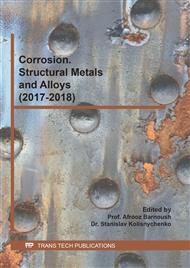p.1853
p.1860
p.1867
p.1874
p.1880
p.1886
p.1892
p.1898
p.1907
Corrosion Mechanisms of New Wrought Mg-Al Based Alloys Alloying with Mn, Zn and Sn
Abstract:
The low density and high strength/weight ratio of magnesium (Mg) and magnesium alloys make them promising candidate materials in light-weight vehicle industries, such as automobile and aerospace, where poor corrosion resistance is a major obstacle in many of their wide-spread applications. Addition of alloying elements with production of wrought Mg alloys with finer microstructure results in enhanced mechanical properties and corrosion resistance. The aim of this research is to study the changes in microstructure caused by addition of alloying elements (zinc (Zn), and tin (Sn)) to new wrought Mg-5Al alloy, and their influence on the alloy's corrosion behavior. The microstructure was investigated using optical and electron microscopy and EDS. The corrosion behavior was analyzed through electrochemical measurements and immersion test. It was found that the corrosion resistance of Mg-5Al alloy was improved by addition of alloying elements, and the amounts of these elements strongly influenced the corrosion behavior of the alloys. Nevertheless, the influence of alloying elements is different for short-term and long-term immersion periods, since the mechanisms of corrosion initiation and corrosion propagation are different.
Info:
Periodical:
Pages:
1880-1885
Citation:
Online since:
December 2018
Authors:
Price:
Сopyright:
© 2018 Trans Tech Publications Ltd. All Rights Reserved
Share:
Citation:



